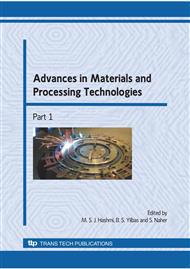p.429
p.439
p.449
p.457
p.465
p.473
p.481
p.489
p.497
Optimization for Secondary Cooling Parameters in Continuous Casting of High Carbon Chromium Bearing Steel
Abstract:
The high carbon chromium bearing steel, as a kind of special steel, entails high quality. The work aims to simulate the solidification process of continuous casting of high carbon chromium bearing steel, to find the cause for defect, and to optimize the secondary cooling parameters steel. A finite element model is developed to compute heat transfer and solidification in bearing continuous casting. By comparing the calculated data with the metallurgical constraints, the key factor caused the cracks on the strand can be found out. Then based on the subproblem approximation method, an optimization program is developed to search out the optimum cooling parameters. Those optimum parameters can meet all specified requirements but with a minimum expense of the operational and the design constraints and can make it possible to run the caster at its maximum productivity, minimum cost and to reduce the defects. Now, online verifying has been obtained with the cracks decreasing and the water consumption of secondary cooling zone saving.
Info:
Periodical:
Pages:
465-472
Citation:
Online since:
December 2009
Authors:
Price:
Сopyright:
© 2010 Trans Tech Publications Ltd. All Rights Reserved
Share:
Citation:


